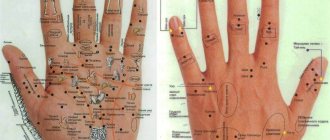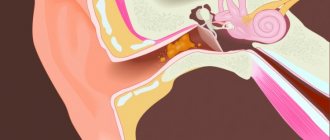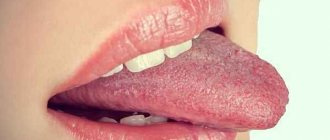What are hand tremors like?
Any hand tremor has the following characteristics:
- Location of the center that generates trembling of the limbs: tremor of central and peripheral origin.
- The presence or absence of a connection with diseases: physiological and pathological hand tremors.
- The amplitude of the movements performed: sweeping, small tremors, imperceptible.
- What it reminds you of: tremor of the fingers, similar to counting coins, rolling pills, etc.
- Time of appearance: tremor of rest or movement.
How does physiological tremor occur?
To understand the mechanism of tremor, you need to remember how ordinary involuntary reflexes are formed. For example, when a person quickly withdraws his finger after touching a hot frying pan or pricking himself on a sewing needle.
A simple reflex arc of a peripheral type.
When excited, sensory receptors responsible for recording pain, temperature or tactile sensations transmit a nerve impulse along the fibers of the sensory nerves to the spinal cord. There, this signal can immediately switch to the fibers of the motor nerve, which causes contraction of the corresponding muscles, and the hand makes movement. All this happens so quickly that the person does not even realize why he pulled his hand back.
How does peripheral (physiological) tremor appear?
When peripheral tremor occurs, almost the same parts of this reflex arc are involved. Only in this case, the signal comes not from sensitive skin receptors, but from special stretch receptors - muscle spindles, which send nerve impulses with some periodicity. The most common type of hand tremors is normal and increased physiological tremor.
Normal physiological tremor is practically invisible to the human eye due to the small amplitude of the movements performed. With excitement or cooling, signals from the muscle spindles to the spinal cord and vice versa are strengthened, so movements made by the fingers, hand or elbow joint become more noticeable - this is an increased physiological tremor.
An important feature of peripheral tremor
. If you take a weight in your hands, the frequency of trembling of the upper limb decreases.
Reasons for the development of the disease
If your fingers twitch regularly or even very rarely, spend a little time analyzing your way of being.
A nervous tic is the result of severe nervous overexcitation, excessive physical activity, or even negative heredity, which can manifest itself at any age, and regardless of gender. In this state, one small muscle or group of muscles begins to contract on its own, not obeying the will of the person, and this phenomenon occurs abruptly, and the contractions are very jerky.
Depending on why a toe or hand is twitching, manifestations of a nervous tic can be:
- Primary when it comes to an independent pathology of the nervous system that arose at a tender age. For example, they are often diagnosed in children aged 5 to 7 years who have become unwitting participants in family quarrels, or victims of psychological/physical violence;
- Secondary, resulting from diseases affecting the brain. Such pathologies appear as a result of hypoxia, tumors, mechanical injuries, impaired metabolism, etc.;
- Tourette's syndrome is another reason why the thumb on the right or left hand twitches. In this case, genetics, uniting direct relatives, are to blame for everything. Here it must be added that manifestations may be different. For example, if a mother involuntarily contracted the muscles around her eye, then her son's tic may manifest itself in the form of an uncontrollable twitching of the head.
If only one finger on the hand twitches, then we are talking about a limited, local or local type of the disease, while its generalized form affects several muscle groups at once. A simple tic involves one action, twitching an eyelid, for example.
In the case when the movements are not controlled, but are coordinated, we are talking about a serious condition in which a person can even jump, regardless of his desires.
Manifestations of nervous tics can have many faces, which is why they are all sorted into three broad groups:
- Facial: eye twitching, winking, winking, moving lips and other actions that involve facial muscles;
- Vocal: curses pronounced without desire, shouting out individual letters, syllables, full words and even sentences, sounds or endings of phrases just heard;
- Tics of the limbs: twitching in the hand, any leg, clapping of hands, stamping and dancing, jumping, etc.
Signs of pathology
A person can learn that his thumb on his right or left hand is twitching from those around him, since for him this action is quite capable of remaining unnoticeable and insignificant. People do not feel the approach of muscle contraction, and can control it only in exceptional cases, and then not for long.
Typically, the muscle twitches more when the patient is nervous or very physically tired. At the moment of emotional stability and a period of rest, contractions weaken and become rare.
Twitching of the right or left limb does not in any way affect productivity, mental abilities or central nervous system activity in general. The only way they harm is a decrease in self-confidence, suppression of the psycho-emotional state, unnecessary attention from others, their ridicule and condemnation. Children are much more susceptible to the last two factors, and therefore their tic increases noticeably in crowded places.
Depending on the cause of the contractions, and if the finger on one hand twitches, and the head or lower limbs do not shake, the doctor chooses the appropriate treatment method.
It usually involves taking medications that normalize the blood supply to the brain, sedatives, and drugs with a neurotoxic effect. The latter have the ability to block the nerve and temporarily eliminate the visible symptoms of tics.
A huge role is played by parallel psychotherapeutic sessions, maximum mobility, passion for what you love and detachment from negative thoughts/sources of stress.
Traditional methods
Our ancestors also looked for the reason why their eye, finger or entire leg twitched.
As expected, this disease was “from nerves”, and therefore it was customary to treat it with decoctions of valerian root and mint tea, local compresses based on chamomile and lemon balm infusions, physical labor and rest.
It is possible that their findings should be included in a modern tic treatment regimen.
A little positivity
If the twitching worries you nothing at all, it is quite possible that they are a harbinger of something important.
According to folk wisdom:
- The twitching thumb of the left hand signals the imminent taking of a leading position, the right one - you need to prepare for sadness;
- When the muscles of the left eye contract, you have to cry, while the right eye has to make donations to the poor;
- A trembling mouth is a sign of joy, and a ringing right ear is a sign of prosperity;
- A moving tongue means a sad journey;
- A trembling crown is sad news from a friend;
- Twitching toes promise profit.
It is quite possible that you do not have a terrible disease at all, but the ability to predict the future. In any case, consult your therapist and avoid stress, it has never benefited anyone.
In this article we will talk about the trouble that is in the title. If the first association that arose in you in connection with the topic under consideration was the shaking fingers of a person who had drunk too much alcohol, then yes, the exercises given here will help him too. Although, in this case it is better to use or. The main purpose of the article is to help those people who have “earned” this unpleasant disease.
That is, for whom trembling fingers are an occupational disease. For example, all kinds of builders and finishers, who often work as hammer drills, drivers of all kinds of excavator and other crane installations, literary workers, proofreaders, and stenographers often complain that their fingers involuntarily shake.
This disease appears due to muscle fatigue when performing monotonous work with the fingers for a long time. The exercises that are proposed for use in the treatment of finger tremors are very complex, but very effective.
Finger trembling can occur for various reasons. This condition is caused by a pulse signal supplied by the nerve endings, resulting in muscle strain and, as a consequence, trembling of the thumb.
A neurologist deals with such problems, but other causes should not be ruled out, for example, stressful situations, which may result in muscle tremors in the area of the thumb. In this case, sometimes it’s enough just to rest and relax more, as well as take herbal medications.
In addition, a common reason why hands twitch may be a lack of potassium, vitamins and minerals in the body. The leaching of potassium from the body can be caused by certain diseases, as well as as a result of taking diuretics. In addition to convulsive contractions in the joints, a lack of potassium negatively affects the functioning of the heart muscle. Therefore, such manifestations require medical consultation and a thorough diagnostic study to select the most adequate therapy.
Alcohol can cause hand tremors, so a complete abstinence from drinking any, even weak, alcoholic drinks is required.
Due to the numerous causes of numbness and convulsive twitching of the limbs, you should contact specialists such as a vertebrologist, neurologist, surgeon and cardiologist. After diagnosis (MRI, X-ray, visual examination and questioning of the patient), the most effective treatment is prescribed, including an individual complex of exercise therapy, local medications, tablets, capsules, etc.
How does pathological tremor occur?
Reflex arc of central type.
In some cases, the signal from the sensory receptors in the spinal cord is not immediately switched to the fibers of the motor nerve, but is sent further to certain structures of the brain, which gives the “command” to make this or that movement.
How does pathological (central) tremor appear?
. In this case, neurons that generate hand tremors appear in the brain. Regardless of the information coming to them from the muscle spindles, they generate their own “commands” that cause the muscles to contract at a certain frequency. Thus, entire neural circles appear through which pathological impulses circulate, causing hand tremors. The most well-known ways of such circulation are:
- Cerebral cortex - spinal cord - thalamus - cortex.
- Cerebral cortex - subcortical structures of the brain (striatum, striatum, lenticular nucleus) - spinal cord - thalamus - cortex.
- Cerebral cortex - cerebellum - thalamus - cortex.
- Cerebellum - red nucleus of the brain - inferior olives - cerebellum.
An important feature of central type tremor
. When the upper limb is weighted, the frequency of hand tremors practically does not decrease.
Treatment with folk remedies
Alternative medicine is actively used in combination with medications. You must take medications prescribed by your doctor.
If the unpleasant symptom is caused by depression, constant stress and nervous tension, then you can get by with traditional medicine:
- Tansy flowers are good for hand tremors. The peas should be chewed, several at a time, and moistened generously with saliva. The plant itself must be spat out, and the juice must be swallowed along with saliva.
- An infusion of medicinal herbs fights tremors well. To prepare the product, you need to take three parts of dry motherwort, two parts of hawthorn, and valerian rhizomes. In addition, you will need chamomile flowers, dried herb, and mint leaves. The components are mixed until a homogeneous mass is formed. Next, pour two tablespoons with several glasses of hot water and leave on the fire for about ten minutes. Then pour into a thermos and leave for a couple of hours. It is advisable to take the tincture three times daily in freshly brewed form. The course of therapy lasts about 30 days. Then you need to take a break of 2 weeks and resume treatment if symptoms return.
- Another effective traditional medicine recipe is fresh Tibetan lofanthus flowers, which should be used both internally and externally. To prepare, you need to chop the flower stalks and add 200 ml of water. The water should be hot, then infuse the broth for about an hour and strain. Take 1/3 part 5 times a day. For facial nerve paralysis, the decoction should be more concentrated.
Oriental therapy will help in the fight against hand tremors. You can get rid of shaking hands with the wise wind, which goes in combination with the wise life. Exercises need to be alternated. What technology? The index finger should reach the base of the thumb. The index finger is fixed with the thumb. Fingers not affected by the exercise should be at rest.
Other hyperkinesis, characterized by shaking of the hands
In addition to tremor, there are other forms of hyperkinesis, when the upper limbs shake. First of all, it is chorea. Chorea.
Unlike ordinary trembling, with chorea the hands shake randomly, making irregular and jerky movements of varying amplitude. The main cause of hand tremors during chorea is a violation of the transmission of nerve impulses along the extrapyramidal pathways or when the basal ganglia of the brain are damaged. In addition to the shaking of the upper limbs, with chorea other parts of the body also make elaborate movements: legs, facial muscles, torso, which outwardly resembles some kind of grotesque dance.
The main causes of chorea:
- infectious diseases: viral, bacterial infections;
- toxic, metabolic disorders;
- rheumatic fever ();
- hereditary diseases - Getington's (Huntington's) chorea, chronic chorea with late onset, non-progressive chorea with early onset;
- paroxysmal choreoathetosis;
- Wilson–Konovalov disease;
- Lesch-Nyhan syndrome and others.
Nervous hand tic
. Externally, a tic can be very reminiscent of tremor or movements during chorea, but its distinctive feature is that it stops the action by force of will. Although hand tics are not as common as vocal or facial forms of this pathology, tics of individual fingers or hands are sometimes encountered.
The cause of tics can be various diseases (for example, a pinched nerve) and psychological experiences.
Myoclonic hand jerking
. These are movements like “shuddering” of the upper limbs, which, with some types of myoclonus, can occur quite often, resembling the pattern of hand tremors and occurring several times during wakefulness or sleep. The main reason for the appearance of such “shaking” of the hands is certain types of epilepsy (for example, Janz) or myoclonic absence seizures of various origins (Tassinari syndrome, etc.).
How to treat an illness if your hands tremble and shake
Medications
Since the main cause of trembling is excitement or overstrain of the nervous system, the doctor first prescribes a sedative - for example, novopassit.
In the case of pronounced psychosomatics of the disease, antidepressants or sleeping pills (zopiclone, zolpidem) may be prescribed.
If the patient's mood improves, the patient's well-being will also improve, and the trembling will subside or stabilize.
If the patient is prone to epilepsy, anticonvulsants can be used, most often hexamidine. It may help stabilize the pre-convulsant state.
It is important to remember that tremor itself is rarely a problem, and its treatment takes place in two stages: relieving tension and pain, solving the root of the problem. You should not wash down chronic tremors with a sedative - this is tantamount to running away from the disease instead of treating it.
What to do?
If you notice shaking in your or your child's hands, you should consult a doctor. To begin with, this could be a pediatrician, therapist, family doctor or neurologist. Hand tremors in themselves do not require diagnosis, but effective treatment requires finding the cause that caused them. For this purpose, after an examination and interview with the patient or the child’s parents, the doctor will prescribe a more in-depth examination, which, in addition to laboratory and instrumental studies, may include consultations with specialized specialists, for example, an epileptologist, psychiatrist, infectious disease specialist, or rheumatologist.












